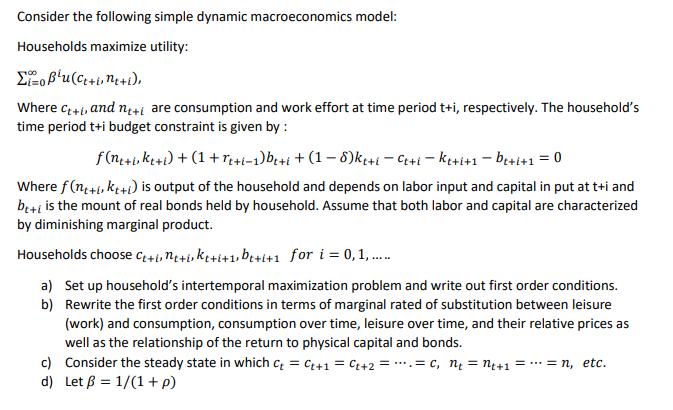Answered step by step
Verified Expert Solution
Question
1 Approved Answer
Consider the following simple dynamic macroeconomics model: Households maximize utility: Ei=0Bu(Ct+i, nt+i), Where Ct+i, and nt+l are consumption and work effort at time period

Consider the following simple dynamic macroeconomics model: Households maximize utility: Ei=0Bu(Ct+i, nt+i), Where Ct+i, and nt+l are consumption and work effort at time period t+i, respectively. The household's time period t+i budget constraint is given by : f(ne+ike+i) + (1 + rt+i-1)be+i+(18)kt+iCt+i - Ke+i+1-bt+i+1 = 0 Where f(nt+i, kt+i) is output of the household and depends on labor input and capital in put at t+i and bt+i is the mount of real bonds held by household. Assume that both labor and capital are characterized by diminishing marginal product. Households choose Ce+in+ke+i+1, be+i+1 for i = 0,1,..... a) Set up household's intertemporal maximization problem and write out first order conditions. b) Rewrite the first order conditions in terms of marginal rated of substitution between leisure (work) and consumption, consumption over time, leisure over time, and their relative prices as well as the relationship of the return to physical capital and bonds. c) Consider the steady state in which Ct = Ct+1 = Ct+2 =.= C n = nt+1 == n, etc. d) Let = 1/(1+ p)
Step by Step Solution
★★★★★
3.45 Rating (155 Votes )
There are 3 Steps involved in it
Step: 1
ANSWER a The households intertemporal maximization problem can be written as max i0 i uc ti n ti sub...
Get Instant Access to Expert-Tailored Solutions
See step-by-step solutions with expert insights and AI powered tools for academic success
Step: 2

Step: 3

Ace Your Homework with AI
Get the answers you need in no time with our AI-driven, step-by-step assistance
Get Started


